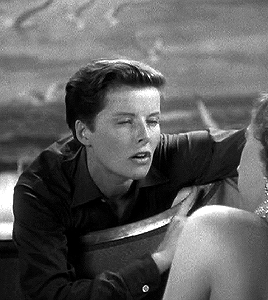#sylvia scarlett
Explore tagged Tumblr posts
Text
As we all know, I'm not very skilled at making edits but y'know I'm practicing. Anyway here's what I worked on today whilst I was definitely paying attention in a seminar.
I guess it's technically Kath and Cary propaganda for @hotvintagepoll but it's so much more Kath than Cary purely because of who I am that it might not count. Anyway 30s wlw mlm solidarity duo my belovedests
#katharine hepburn#cary grant#sylvia scarlett#holiday (1938)#bringing up baby#the philadelphia story (1940)#why are my movie tags so inconsistent I need to fix that at some point#oh yeah also#abba
119 notes
·
View notes
Text
Sylvia Scarlett (1935)
I've been looking more into pre-code Hollywood, since censorship has been a theme in US politics...
and man. When you think of things that got banned you kinda just think of very surface level sex stuff and gay stuff, like kissing, or a bare shoulder (gasp!)
but this struck me. maybe it's ignorant of me but I just never would've thought a moment like this would be put in a film from the 1930s, let alone like...any time in the last several decades lol.
it's intimate moments and representation like this that was lost, and more will be lost moving forward. It makes me happy this always existed and had at least a moment thriving in the public eye, but sad it's under fire yet again.
#art#movies#cinema#old hollywood#trans#transgender#trans man#transman#trans rights#trans pride#ftm#queer art#queer culture#queer community#transmasc#trans masc#sylvia scarlett#katharine hepburn#old movies
48 notes
·
View notes
Text
Behind every queer woman obsessed with vintage films is a deep love for The Children's Hour, Queen Christina, Morocco, and Sylvia Scarlett
#butch katharine hepburn did things to me#so did garbo and marlene crosssdressing and lesbian shirley maclaine#the children's hour#queen christina#morocco#sylvia scarlett#marlene dietrich#audrey hepburn#greta garbo#shirley maclaine#katharine hepburn#lesbian#wlw#sapphic#old hollywood#classic hollywood
26 notes
·
View notes
Text

Screenland magazine, January 1936
#first of many#katharine hepburn#cary grant#sylvia scarlett#hollywood#old hollywood#classic hollywood#1936#1935#1930s#vintage hollywood#screenland#screenland magazine#magazine#movie magazine
25 notes
·
View notes
Text

Katharine Hepburn in Sylvia Scarlett, 1935
204 notes
·
View notes
Text
save me Katharine Hepburn in drag as Sylvester Scarlett in the film Sylvia Scarlett.


Katharine Hepburn in drag as Sylvester Scarlett in the film Sylvia Scarlett save me
#katharine hepburn#sylvia scarlett#black and white#cinema#feeling some kind of wayy#some kind of way meaning lesbian#drag#lesbian
128 notes
·
View notes
Text

Clarulitas Katharine Hepburn in Sylvia Scarlett (1935) 2024
#katharine hepburn#sylvia scarlett#old hollywood#1930s#film#movie poster#art#fanart#brart#brazilian artists#artists on tumblr#digital painting#by clarulitas
24 notes
·
View notes
Text
To anyone asking where my gender chaos comes from: I was socialized as female, but these were my role models/fave movies growing up:
Dame Julie Andrews in Victor Victoria - 1982


Katherine Hepburn in Sylvia Scarlett - 1935

Also, I am queer AF
#dianneking#dianneking rambles#Gender chaos#queerness#I might have been a weird kid#But then I became a weird adult so all is well#victor victoria#Victor Victoria 1982#sylvia scarlett#Katherine Hepburn#dame julie andrews#Gender envy#gender? i hardly know her
114 notes
·
View notes
Text

#Katharine Hepburn#Cary Grant#Edmund Gwenn#Sylvia Scarlett#1930s#black and white#chiaroscuro#George Cukor
3 notes
·
View notes
Text
Why she hop around like that?
#i'm cackling why does Katherine Hepburn have her hands around my little lesbian heart?#sylvia scarlett#katherine hepburn
4 notes
·
View notes
Text

#submitted#movies#polls#sylvia scarlett#katharine hepburn#cary grant#george cukor#adaptations#ended#result: unheard of
3 notes
·
View notes
Text
my katharine hepburn phase was so funny i went through most of her discography completely happy with the screwball comedies and whatever the hell stage door was and then i got to sylvia scarlett (1935) like. alright buddy what's all this then
#genuinely one of the most insane plots ive ever seen like they just did WHATEVER back then#i was out of it by the time jules showed me lion in winter which is genuinely a top ten movie of all time for me now#but like holiday....and woman of the year.....and the philadelphia story about seven different times#and the other one with cary grant that was kinda mid amy something? something adams? it was alliterative#sylvia scarlett
8 notes
·
View notes
Photo
1935

Katharine Hepburn on the set of Sylvia Scarlett (1935, dir. George Cukor) (via)
3K notes
·
View notes
Text

Screenland magazine, January 1936
#katharine hepburn#sylvia scarlett#bunny beatty#1935#1936#1930s#hollywood#old hollywood#classic hollywood#vintage hollywood#screenland#screenland magazine#magazine#movie magazine
20 notes
·
View notes
Text
Katharine Hepburn jumping fences circa 1933


18 notes
·
View notes



